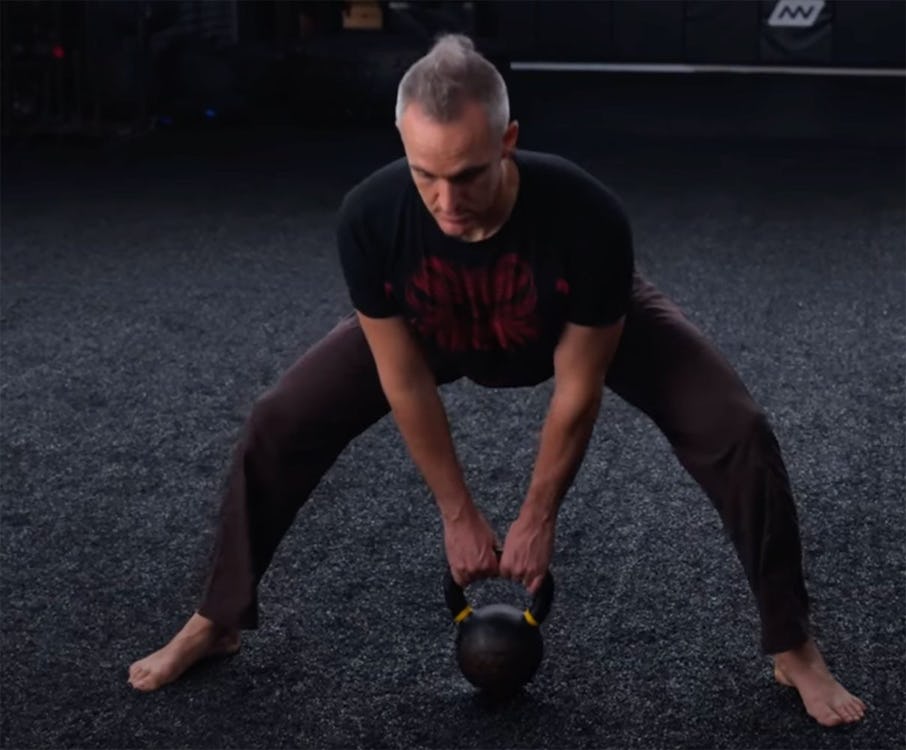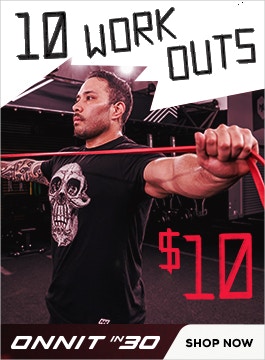The deadlift is a foundational movement pattern that builds your glutes, hamstrings, lower back, and all-around hip extension strength. Deadlifting is beneficial to anyone who plays sports, or who just wants to be strong and slow down the aging process. Though most famously done with a barbell, deadlifting with one or more kettlebells is a more than adequate substitute that offers several other benefits as well.
Here, we present some of the most common and effective kettlebell deadlift variations.
What Is The Kettlebell Deadlift and What Are The Benefits of Doing Them?
(See 00:31 in the video above.)
“The deadlift itself is a hinge movement,” says Shane Heins, Onnit’s Director of Fitness Education. “You fold at the hips to pick objects up from down below.” If that motion looks familiar to you, it should—you probably do it every day, from picking up your gym bag to lifting your little brother/sister, or son/daughter, into the car seat. The point is, few exercises prepare you for the sport of life like the deadlift does.
That’s not to say it can’t prepare you for actual sports too. The deadlift trains the muscles that extend the hips—the glutes and hamstrings—which are the source of speed and power for virtually all explosive movements (yes, the quads get some work too, extending the knees in concert with the hips). Deadlifting also involves the upper and lower back, as well as the forearm and gripping muscles, so deadlifts of any kind are really full-body exercises.
When you swap out a barbell for a kettlebell, things get even more interesting. Deadlifting with a barbell is hell on your grip, but the challenge increases with a kettlebell, both because the diameter of the handle is thicker and the weight’s center of gravity is lower. That makes the kettlebell much harder to control, upping the strength requirement from both your hands and your core. Another point: the shape and length of a barbell makes it only suitable for lifting right in front of you, with your palms facing your body. A kettlebell, however, can be positioned between your legs, to the outside of one leg, or at varying heights depending on your goals. You can also grip it with your hands at a 45-degree angle or palms facing in, so the kettlebell is a bit more versatile.
Heins argues that the kettlebell is “much more closely related to the types of objects you’ll deadlift, and how you’ll deadlift them, in your day-to-day life.”
How To Do The Single-Leg Kettlebell Deadlift
(See 01:17 in the video.)
The single-leg kettlebell deadlift works the glutes, hamstrings, and lower back one side at a time, which allows you to train them through a greater range of motion than you could with conventional two-legged deadlifts. We recently posted a thorough article tutorial on the single-leg deadlift and all its glory, so check that out separately.
How To Do The Kettlebell Romanian Deadlift (RDL)
(See 01:49 in the video.)
Prolonged bouts of sitting cause the hamstrings to shorten, reducing their flexibility. The Romanian deadlift helps to stretch them back out again, while also working the glutes through a full range of motion. Doing an RDL with a kettlebell is a good way to prepare your body for more dynamic hip hinge movements like the kettlebell swing, as it strengthens the same muscles and works you through the same range, but without the momentum that puts the lower back at some risk.
Step 1. Set a kettlebell on the floor just in front of you. Place your feet hip-distance apart. Draw your shoulders back and down (think “proud chest”), pull your ribs down, and brace your core. Unlock your knees.
Step 2. Keeping a long spine from your head to your tailbone, drive your hips back as far as you can so your torso folds over. Let the movement come from your hips (do NOT round your lower back). Stop when you run out of range—your shoulders should end up above hip level. Grasp the kettlebell with both hands.
Step 3. Keeping your proud chest position, drive through your heels as you extend your hips and knees to stand up tall. Now you’re in position to BEGIN your reps.
Step 4. Bend your hips back as you did above to lower the weight to just above the floor—don’t let it rest on the ground. You may need to stand on some mats or other elevated surface to do so. The goal should be to keep constant tension on your muscles, and stopping the weight on the floor allows them a momentary rest.
How To Do The Kettlebell Sumo Deadlift
If your hamstrings are tight, you may have an easier time doing the sumo deadlift than the RDL. The sumo requires less of a hip hinge, but it also lets you work with heavier weights, and it gets the adductors (inner-thigh muscles) in on the action to a greater degree than other deadlifts.
Step 1. Stand with your feet wider than shoulder width, and turn your toes out 45 degrees. Actively drive your knees outward. Assume a proud chest position.
Step 2. Hinge your hips back while keeping a long spine, and grasp the kettlebell with both hands.
Step 3. Drive through your feet to extend your hips to stand tall. Think about pulling through the crown of your head.
How To Do The Kettlebell Suitcase Deadlift
(See 03:42 in the video.)
Lifting a kettlebell on one side of the body alone “starts to tap into that corset of core musculature from the hips to the shoulders,” says Heins, “while also challenging your grip.” Most of life and sport activities load the body asymmetrically, so it pays to train this way.
Step 1. Set the kettlebell to the side of one leg with the handle turned vertical (so you can pick up the bell as if it were a suitcase). Place your feet at hip width, get a proud chest, and draw your ribs down. Brace your core.
Step 2. Hinge your hips first and then bend your knees just enough to reach the kettlebell. Maintain a long spine as you do this. (Think about the logo on your T-shirt—it should be visible to anyone standing in front of you.)
Step 3. Drive your feet through the floor and extend your hips to stand tall. Lift the weight evenly. Because you’re loading your body unevenly, it will be difficult to keep your shoulders square and your torso straight, but avoid any twisting or bending.
Be sure to perform the exercise for an even number of reps on both sides.
How To Do A Double-Kettlebell Deadlift
(See 05:16 in the video.)
Deadlifting two kettlebells at once really forces you to brace your core and coordinate an unstable movement. It’s tough on your grip, and allows you to lift heavier than most other kettlebell deadlift variations, increasing the muscle-building potential.
Step 1. Place two kettlebells on the floor and stand with them between your legs, feet a little wider than your hips. Draw your shoulders back and put a soft bend in your knees.
Step 2. Hinge your hips to reach the kettlebells. Be sure to really push your hips back, bending your knees only as needed to grasp the bells.
Step 3. Drive your feet through the floor and stand tall. As you return the kettlebells to the floor, think about sitting your hips back rather than just bending forward.
Stretching Before Deadlifting
Perform the following mobility routine from Onnit-certified coach Eric Leija (@primal.swoledier) before you take on any of the deadlifts listed here. It will stretch out your hips, glutes, and hamstrings for the work to come, and raise your core temperature for safer training.
How To Modify Your Deadlift For Your Goals
“It’s easy to fall into the trap of ’I see the movement being done this way and this is the only way I can ever do it,’” says Heins of the deadlifts we outlined above. But he wants to remind you that the beauty of kettlebells is their versatility—you can use them in a variety of ways that help you accomplish exactly what you want with your training at whatever level you find yourself.
For instance, if you want to improve mobility in your hips and hamstrings, Heins says you can perform the double kettlebell deadlift with a single leg. If you want to go really heavy on your double deadlift, do it with a sumo stance. Want to build rock-solid balance and stability? Do the suitcase deadlift single-leg style. And if you find that you don’t have the mobility to perform a deadlift safely, do it from an elevated surface (such as a box or mats) to cut down on the range of motion. “I’d rather see you cut range than get hurt trying to force a range you don’t have yet,” says Heins.
So get creative and play with these variations to find what suits you best. As long as you observe the basic form pointers—flat back, proud chest, moving at the hips instead of the low back—you’ll have an almost infinite number of kettlebell deadlifts to work on.
How To Incorporate These Exercises Into Your Workouts
(See 09:21 in the video.)
Deadlifts generally let you go pretty heavy, so Heins says they work well when serving as the main strength exercise in your workout. After you’ve warmed up and done any plyometric (explosive) or high-skill exercises, such as jumps or cleans, a double-kettlebell deadlift or sumo deadlift is a great movement to strengthen the lower body. Do sets of 3–5 reps if you have access to really heavy kettlebells, while 8–12 reps is fine for moderate ones.
“You can also use deadlifts for circuits for conditioning,” says Heins, or muscular endurance. “The kettlebell lets you notch back the weight you’re working with so you can do the deadlift for higher reps and with shorter rest periods,” something that isn’t so practical when using a barbell and plates. Romanian deadlifts are a good choice in this case, as are double-kettlebell sumo deadlifts done with lighter bells. Heins says that the latter is a good way to focus on opening up range of motion in the hips and adductors.
Yet another use for deadlifts is for simulating more athletic and real-world movements, like lifting uneven loads. You can place suitcase and single-leg deadlifts pretty much anywhere in your workout to train your ability to stabilize your body as well as even out muscle imbalances between sides. “These don’t need to be high repetition or heavy,” says Heins. “Work with a weight that allows you to hold structural integrity and perform reps with the utmost beauty.”

)





